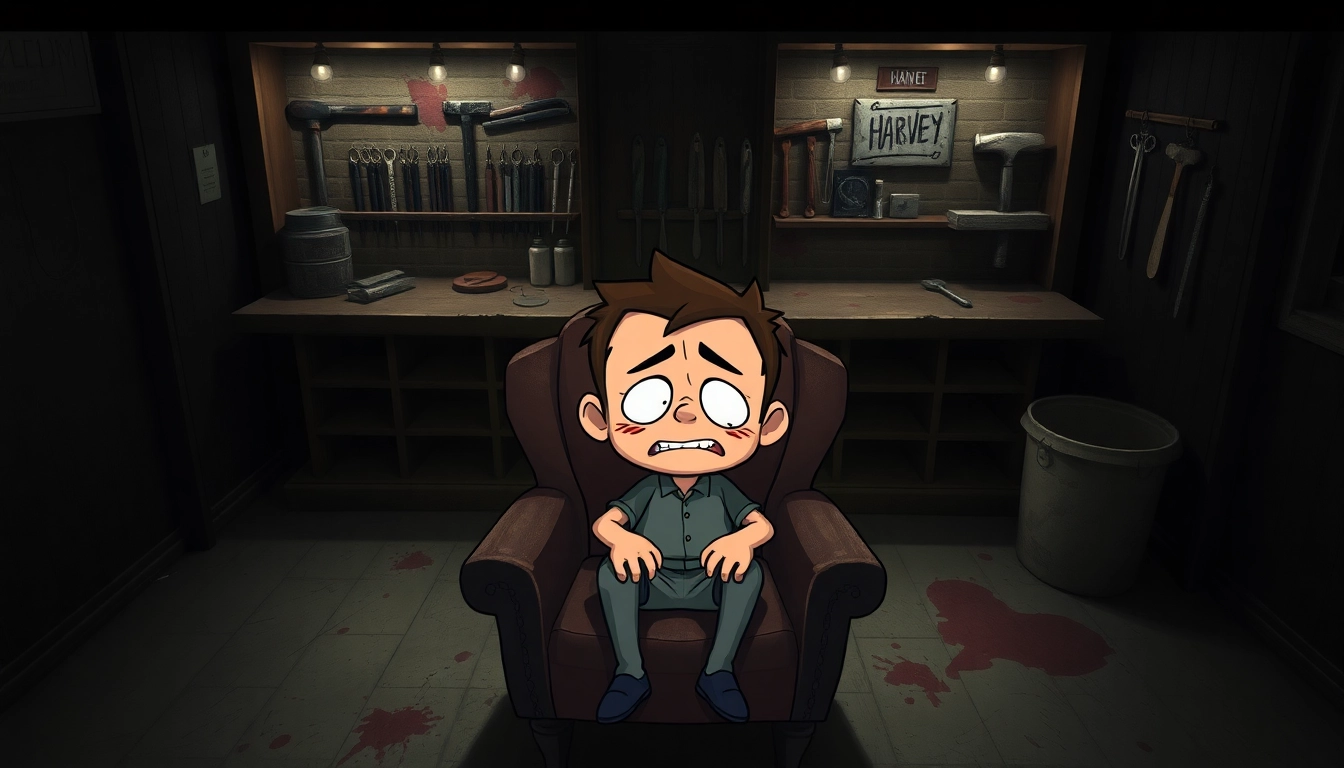Introduction to BLOODMONEY and Its Dark Premise
In the realm of psychological horror and morally challenging gameplay, bloodmoney harvey stands out as a haunting experience that pushes players to confront their own ethical boundaries. This game, often described as a dark clicker adventure, immerses players in a disturbing scenario where each click not only generates money but also chips away at their moral integrity. Set against a bleak backdrop of desperation, BLOODMONEY challenges players to navigate a treacherous path where survival depends on choices that can corrupt or preserve their humanity. The core premise revolves around a character diagnosed with a serious medical condition requiring an exorbitant $25,000 for treatment—a sum that seems impossible to gather through conventional means. In this desperate situation, an unsettling opportunity emerges: clicking on a cheerful character named Harvey to earn money. However, this act comes with a sinister cost, making the game a compelling exploration of moral decay in the face of survival.
The Gameplay Mechanics: Clicking, Upgrades, and Moral Choices
Core Gameplay: Clicking for Cash
At its heart, BLOODMONEY is a clicker game—simple yet profoundly disturbing. Players repeatedly click on Harvey, a seemingly innocent and cheerful character, to generate incremental income. Each click increases the player’s total funds, bringing them closer to their financial goal of $25,000. The mechanics are straightforward: the more you click, the more money you earn. But the game’s brilliance lies in its subtle escalation. Harvey’s reactions change subtly with each click; his expressions become more strained, and his dialogue hints at growing discomfort. Visual cues such as Harvey’s increasingly distressed appearance and dialogue reinforce the emotional toll of each action, immersing players in a visceral experience that questions the morality of their choices.
Upgrade System: Tools of Increasing Violence
As players progress, they are presented with the opportunity to purchase upgrades from the in-game shop. Initially, these upgrades are innocuous—perhaps a pillow for pillow fights or harmless tools. However, the shop gradually introduces more violent and disturbing items such as needles, knives, and hammers. Each upgrade boosts the amount of money earned per click, creating a twisted risk-reward dynamic: the more violent the tool, the faster the funds accumulate, but at a greater moral and emotional cost. The game cleverly ties visual and auditory cues to these upgrades. For example, Harvey’s pain becomes more pronounced, his facial expressions more anguished, and his dialogue more desperate, emphasizing the psychological horror of the escalating violence.
Multiple Pathways and Moral Divergence
One of the game’s most compelling features is its multiple pathways—choices that lead to different endings. Players can opt to minimize Harvey’s suffering by sticking to less violent tools, or they can choose to maximize profit, regardless of Harvey’s pain. These choices are not merely binary; they are embedded in the gameplay, influencing how Harvey reacts and how the narrative unfolds. The game subtly tracks these decisions, ensuring that each playthrough offers unique insights into the moral landscape of the player. The different pathways serve as a mirror to human morality: will you act compassionately or ruthlessly when faced with impossible odds?
The Psychological Horror Elements and Visual Storytelling
Visual Cues and Atmosphere
BLOODMONEY excels in creating an unsettling atmosphere through minimalist yet highly effective visual storytelling. Harvey’s appearance deteriorates with each click—his eyes grow more hollow, his posture more fragile, and his expressions increasingly pained. The game employs subtle visual cues—flickering lights, distorted backgrounds, and unsettling sound effects—to amplify the sense of dread. These elements work together to evoke a psychological horror experience that gradually intensifies, making players question the morality of their actions while also feeling a sense of visceral discomfort.
Dialogue and Character Development
Harvey’s dialogue is crafted to mirror his physical deterioration and emotional distress. Initially, he appears cheerful and eager to help, but as the game progresses, his words become strained, pleading, or even accusatory. The game’s narrative design cleverly uses dialogue to deepen the moral conflict, forcing players to confront the human cost of their greed. The subtle shifts in Harvey’s speech serve as a mirror to the player’s own moral choices, blurring the lines between innocence and suffering.
Harvey’s Character: Innocence Versus Suffering
Harvey begins as a cheerful, seemingly harmless figure—an embodiment of innocence and goodwill. His name and demeanor evoke a sense of trust and warmth, making the act of clicking on him feel initially trivial. However, as the game unfolds, the contrast between his innocence and the increasing violence of the upgrades creates a stark moral dilemma. Harvey’s reactions—ranging from confusion to despair—highlight the human toll of the player’s choices. Observant players have noted that Harvey appears genuinely surprised by the more violent tools, such as hammers or needles, suggesting he may not fully comprehend what is happening to him. This detail adds a layer of complexity, implying that Harvey might be unaware of the true nature of the shop’s offerings, which raises questions about innocence, exploitation, and moral responsibility.
The Moral Dilemmas: Minimal Harm vs. Maximizing Profit
Choosing the Path of Compassion
Players who opt for minimal harm focus on using less violent tools—perhaps scissors or pillows—to maximize their earnings with the least amount of suffering. This approach aligns with a moral stance of compassion, attempting to minimize Harvey’s pain while still progressing toward the financial goal. The game rewards this path with the Good Ending, where Harvey’s appearance remains relatively intact, and his reactions show a glimmer of hope. This ending invites reflection on the importance of empathy and restraint, even in desperate circumstances.
Embracing Ruthless Efficiency
Conversely, some players choose to push the boundaries, using the most violent tools available—such as knives or hammers—to accelerate their progress. This approach sacrifices Harvey’s well-being entirely, leading to the Bad Ending. Here, Harvey’s suffering is immense, his appearance grotesque, and his dialogue filled with despair. This pathway underscores the dark reality of moral compromise, illustrating how greed and desperation can erode human decency.
The Middle Ground: Balanced Choices
It’s also possible to adopt a balanced approach, mixing tools and strategies to reach the goal without pushing Harvey to the brink. This nuanced path can lead to the Normal Ending, which presents a more complex moral picture—highlighting the ambiguity of survival ethics. The game’s subtle tracking of choices emphasizes that morality is rarely black and white, especially under extreme pressure.
Endings Explained: Good, Normal, and Bad Outcomes
The Good Ending
Achieving the Good Ending requires players to prioritize Harvey’s suffering minimal while reaching the $25,000 goal. This often involves using less violent tools and avoiding unnecessary escalation. Harvey’s appearance remains relatively intact, and the narrative concludes with a sense of moral victory—highlighting compassion and restraint. This ending prompts players to consider the value of empathy and the importance of maintaining moral integrity even when survival seems impossible.
The Normal Ending
The Normal Ending is attainable through a balanced use of tools, sometimes employing moderate violence. Harvey’s suffering is evident but not overwhelming, and the story concludes with a more ambiguous resolution—neither entirely condemning nor praising the player’s choices. This ending reflects the moral complexity of desperate situations, suggesting that survival often comes with compromise.
The Bad Ending
The Bad Ending is achieved by maximizing violence, using the most brutal tools available, regardless of Harvey’s suffering. Harvey’s appearance is grotesque, his dialogue filled with pain, and the game ends on a note of moral failure. This pathway serves as a stark warning about greed and cruelty, illustrating how moral boundaries can be shattered when survival is at stake.
The Deeper Meaning: Human Nature and Moral Boundaries
BLOODMONEY is more than a simple clicker game—it’s a profound exploration of human morality. Harvey symbolizes innocence and hope, while the shop and its violent tools evoke darker aspects of human nature—greed, exploitation, and moral compromise. The game challenges players to reflect on whether they can maintain their integrity when pushed to the brink. Are we inherently good, or does desperation reveal our true nature? The subtle cues, dialogue, and visual storytelling all serve to interrogate these questions, making BLOODMONEY a mirror to the moral choices we face in real life.
Multiple playthroughs reveal that even with the most violent tools, it’s possible to reach the Good Ending, suggesting that moral resilience is still within reach. Conversely, succumbing to greed and violence leads to destructive outcomes, emphasizing that the path we choose defines our humanity. The game masterfully captures the duality of human morality, forcing players to confront uncomfortable truths about their own character and the true cost of survival.
Community Insights and Player Reactions
The BLOODMONEY community is vibrant and introspective, with players sharing their experiences and moral reflections. Many discuss how the game’s emotional impact extends beyond entertainment, prompting genuine feelings of guilt and empathy. Some players have expressed surprise at how effectively the game evokes empathy, despite its simple mechanics. Others appreciate the nuanced approach to morality, recognizing that the game doesn’t offer easy answers but instead encourages reflection on complex ethical dilemmas.
Content creators and streamers have also highlighted how different choices lead to dramatically different outcomes, emphasizing replayability and moral exploration. The game’s subtle tracking of player decisions adds depth, making each playthrough a unique moral experiment. Overall, BLOODMONEY has sparked conversations about the nature of morality, the limits of compassion, and the human capacity for cruelty under pressure.
Conclusion: Confronting Morality in the Face of Desperation / The Moral Abyss of BLOODMONEY: How Far Would You Go for Survival?
BLOODMONEY offers a haunting reflection on the human condition, blending minimalist gameplay with profound moral questions. It challenges players to consider how far they are willing to go when faced with life-and-death decisions, and whether survival justifies the means. The game’s unsettling atmosphere and layered storytelling serve as a powerful reminder that morality isn’t static—it’s tested and shaped by circumstances, often revealing our true nature.
Through its multiple endings and subtle moral tracking, BLOODMONEY invites players to examine their values and confront uncomfortable truths about greed, compassion, and human resilience. Are you capable of maintaining your integrity when every click demands a moral price? Or will you surrender to the darkness in pursuit of survival? The answer lies within each decision, each upgrade, and each path chosen. Ultimately, BLOODMONEY isn’t just a game—it’s a mirror held up to our own moral boundaries, asking: how far are you willing to go for survival?
If you’re interested in exploring more stories like this or diving into other unsettling experiences, don’t forget to check out bloodmoney. It’s a stark reminder that in the depths of desperation, our morality can be the first casualty.

